MKTG209: Comprehensive Analysis of Digital Marketing Lecture Notes
VerifiedAdded on 2021/08/16
|7
|3112
|49
Report
AI Summary
This report summarizes lecture notes on digital marketing, encompassing foundational concepts such as website design, including usability and conversion-centered design principles. It explores the objectives of websites, including earning revenue through various traffic sources: direct, referral, and search, and delves into conversion strategies and lead generation techniques. The report also covers web design frameworks, segmentation, and mobile-first approaches. Furthermore, it examines analytics, demand generation, and demand harvesting, with a focus on attribution analysis and practical analytics skills using Google Tag Manager. Finally, the report explores search engine optimization (SEO), including keyword usage, the five components of SEO, and the importance of creating high-quality webpages to improve search rankings and reduce bounce rates. The report also touches on the connected space including the components of SEO.
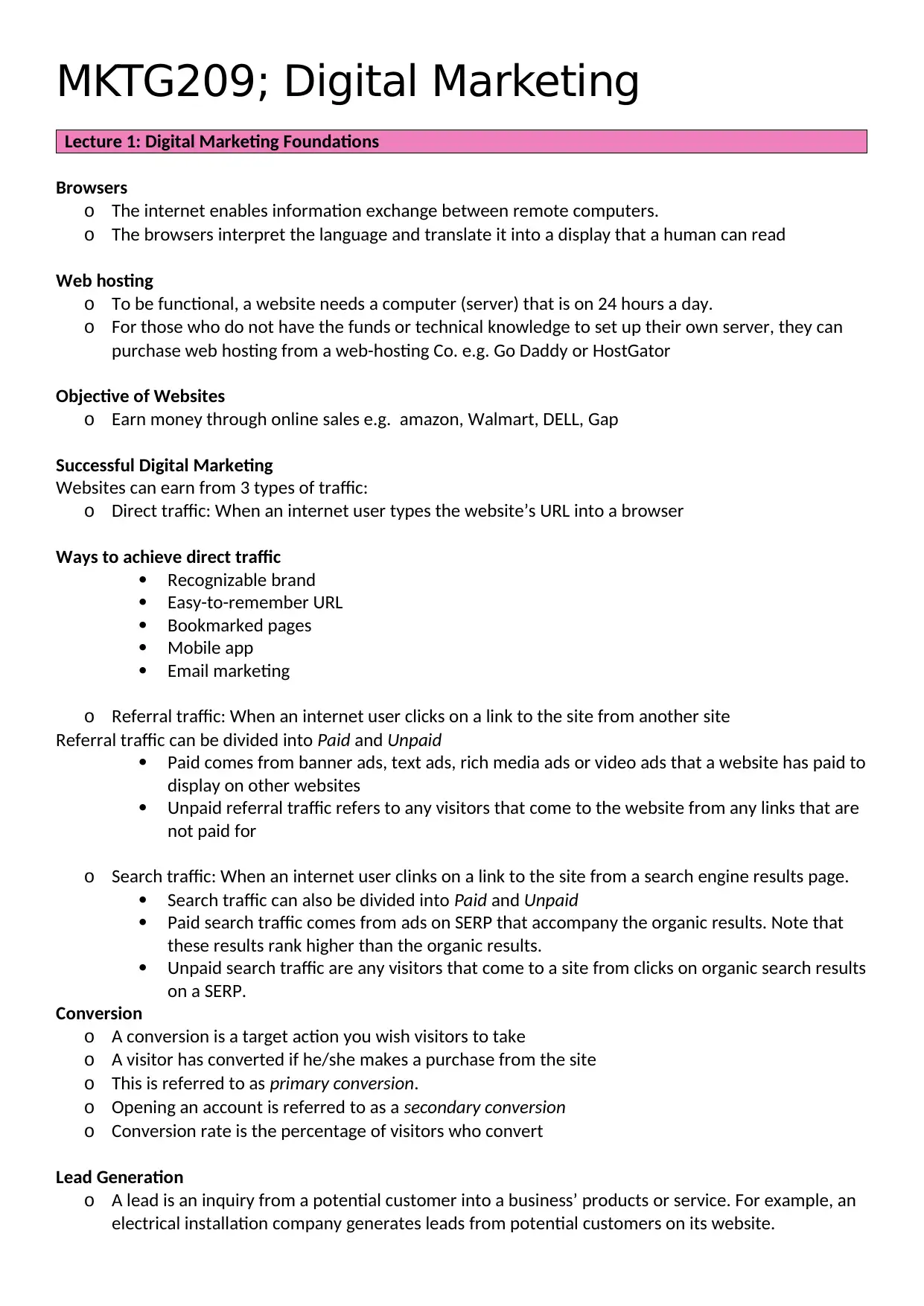
MKTG209; Digital Marketing
Lecture 1: Digital Marketing Foundations
Browsers
o The internet enables information exchange between remote computers.
o The browsers interpret the language and translate it into a display that a human can read
Web hosting
o To be functional, a website needs a computer (server) that is on 24 hours a day.
o For those who do not have the funds or technical knowledge to set up their own server, they can
purchase web hosting from a web-hosting Co. e.g. Go Daddy or HostGator
Objective of Websites
o Earn money through online sales e.g. amazon, Walmart, DELL, Gap
Successful Digital Marketing
Websites can earn from 3 types of traffic:
o Direct traffic: When an internet user types the website’s URL into a browser
Ways to achieve direct traffic
Recognizable brand
Easy-to-remember URL
Bookmarked pages
Mobile app
Email marketing
o Referral traffic: When an internet user clicks on a link to the site from another site
Referral traffic can be divided into Paid and Unpaid
Paid comes from banner ads, text ads, rich media ads or video ads that a website has paid to
display on other websites
Unpaid referral traffic refers to any visitors that come to the website from any links that are
not paid for
o Search traffic: When an internet user clinks on a link to the site from a search engine results page.
Search traffic can also be divided into Paid and Unpaid
Paid search traffic comes from ads on SERP that accompany the organic results. Note that
these results rank higher than the organic results.
Unpaid search traffic are any visitors that come to a site from clicks on organic search results
on a SERP.
Conversion
o A conversion is a target action you wish visitors to take
o A visitor has converted if he/she makes a purchase from the site
o This is referred to as primary conversion.
o Opening an account is referred to as a secondary conversion
o Conversion rate is the percentage of visitors who convert
Lead Generation
o A lead is an inquiry from a potential customer into a business’ products or service. For example, an
electrical installation company generates leads from potential customers on its website.
Lecture 1: Digital Marketing Foundations
Browsers
o The internet enables information exchange between remote computers.
o The browsers interpret the language and translate it into a display that a human can read
Web hosting
o To be functional, a website needs a computer (server) that is on 24 hours a day.
o For those who do not have the funds or technical knowledge to set up their own server, they can
purchase web hosting from a web-hosting Co. e.g. Go Daddy or HostGator
Objective of Websites
o Earn money through online sales e.g. amazon, Walmart, DELL, Gap
Successful Digital Marketing
Websites can earn from 3 types of traffic:
o Direct traffic: When an internet user types the website’s URL into a browser
Ways to achieve direct traffic
Recognizable brand
Easy-to-remember URL
Bookmarked pages
Mobile app
Email marketing
o Referral traffic: When an internet user clicks on a link to the site from another site
Referral traffic can be divided into Paid and Unpaid
Paid comes from banner ads, text ads, rich media ads or video ads that a website has paid to
display on other websites
Unpaid referral traffic refers to any visitors that come to the website from any links that are
not paid for
o Search traffic: When an internet user clinks on a link to the site from a search engine results page.
Search traffic can also be divided into Paid and Unpaid
Paid search traffic comes from ads on SERP that accompany the organic results. Note that
these results rank higher than the organic results.
Unpaid search traffic are any visitors that come to a site from clicks on organic search results
on a SERP.
Conversion
o A conversion is a target action you wish visitors to take
o A visitor has converted if he/she makes a purchase from the site
o This is referred to as primary conversion.
o Opening an account is referred to as a secondary conversion
o Conversion rate is the percentage of visitors who convert
Lead Generation
o A lead is an inquiry from a potential customer into a business’ products or service. For example, an
electrical installation company generates leads from potential customers on its website.
Paraphrase This Document
Need a fresh take? Get an instant paraphrase of this document with our AI Paraphraser
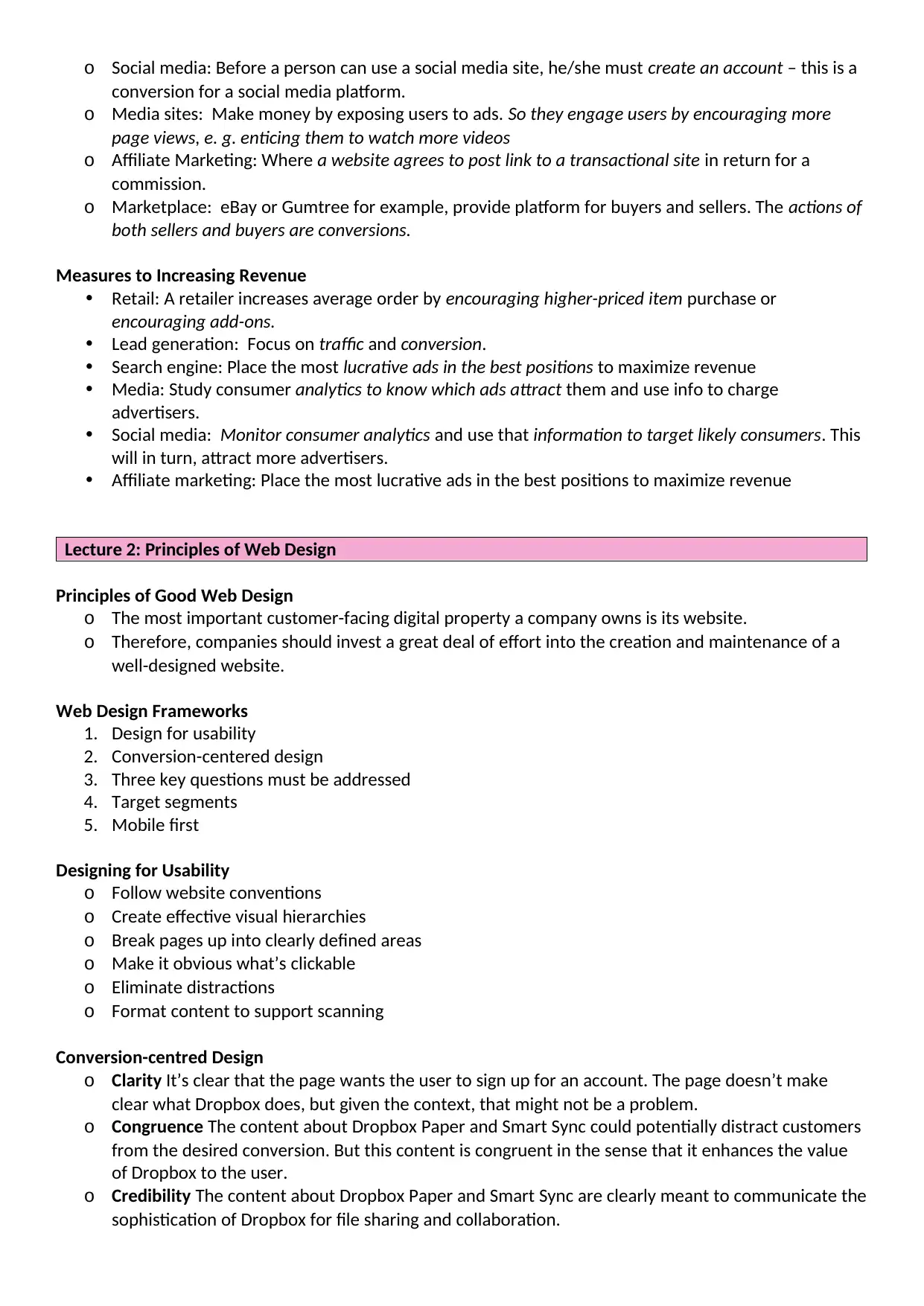
o Social media: Before a person can use a social media site, he/she must create an account – this is a
conversion for a social media platform.
o Media sites: Make money by exposing users to ads. So they engage users by encouraging more
page views, e. g. enticing them to watch more videos
o Affiliate Marketing: Where a website agrees to post link to a transactional site in return for a
commission.
o Marketplace: eBay or Gumtree for example, provide platform for buyers and sellers. The actions of
both sellers and buyers are conversions.
Measures to Increasing Revenue
• Retail: A retailer increases average order by encouraging higher-priced item purchase or
encouraging add-ons.
• Lead generation: Focus on traffic and conversion.
• Search engine: Place the most lucrative ads in the best positions to maximize revenue
• Media: Study consumer analytics to know which ads attract them and use info to charge
advertisers.
• Social media: Monitor consumer analytics and use that information to target likely consumers. This
will in turn, attract more advertisers.
• Affiliate marketing: Place the most lucrative ads in the best positions to maximize revenue
Lecture 2: Principles of Web Design
Principles of Good Web Design
o The most important customer-facing digital property a company owns is its website.
o Therefore, companies should invest a great deal of effort into the creation and maintenance of a
well-designed website.
Web Design Frameworks
1. Design for usability
2. Conversion-centered design
3. Three key questions must be addressed
4. Target segments
5. Mobile first
Designing for Usability
o Follow website conventions
o Create effective visual hierarchies
o Break pages up into clearly defined areas
o Make it obvious what’s clickable
o Eliminate distractions
o Format content to support scanning
Conversion-centred Design
o Clarity It’s clear that the page wants the user to sign up for an account. The page doesn’t make
clear what Dropbox does, but given the context, that might not be a problem.
o Congruence The content about Dropbox Paper and Smart Sync could potentially distract customers
from the desired conversion. But this content is congruent in the sense that it enhances the value
of Dropbox to the user.
o Credibility The content about Dropbox Paper and Smart Sync are clearly meant to communicate the
sophistication of Dropbox for file sharing and collaboration.
conversion for a social media platform.
o Media sites: Make money by exposing users to ads. So they engage users by encouraging more
page views, e. g. enticing them to watch more videos
o Affiliate Marketing: Where a website agrees to post link to a transactional site in return for a
commission.
o Marketplace: eBay or Gumtree for example, provide platform for buyers and sellers. The actions of
both sellers and buyers are conversions.
Measures to Increasing Revenue
• Retail: A retailer increases average order by encouraging higher-priced item purchase or
encouraging add-ons.
• Lead generation: Focus on traffic and conversion.
• Search engine: Place the most lucrative ads in the best positions to maximize revenue
• Media: Study consumer analytics to know which ads attract them and use info to charge
advertisers.
• Social media: Monitor consumer analytics and use that information to target likely consumers. This
will in turn, attract more advertisers.
• Affiliate marketing: Place the most lucrative ads in the best positions to maximize revenue
Lecture 2: Principles of Web Design
Principles of Good Web Design
o The most important customer-facing digital property a company owns is its website.
o Therefore, companies should invest a great deal of effort into the creation and maintenance of a
well-designed website.
Web Design Frameworks
1. Design for usability
2. Conversion-centered design
3. Three key questions must be addressed
4. Target segments
5. Mobile first
Designing for Usability
o Follow website conventions
o Create effective visual hierarchies
o Break pages up into clearly defined areas
o Make it obvious what’s clickable
o Eliminate distractions
o Format content to support scanning
Conversion-centred Design
o Clarity It’s clear that the page wants the user to sign up for an account. The page doesn’t make
clear what Dropbox does, but given the context, that might not be a problem.
o Congruence The content about Dropbox Paper and Smart Sync could potentially distract customers
from the desired conversion. But this content is congruent in the sense that it enhances the value
of Dropbox to the user.
o Credibility The content about Dropbox Paper and Smart Sync are clearly meant to communicate the
sophistication of Dropbox for file sharing and collaboration.
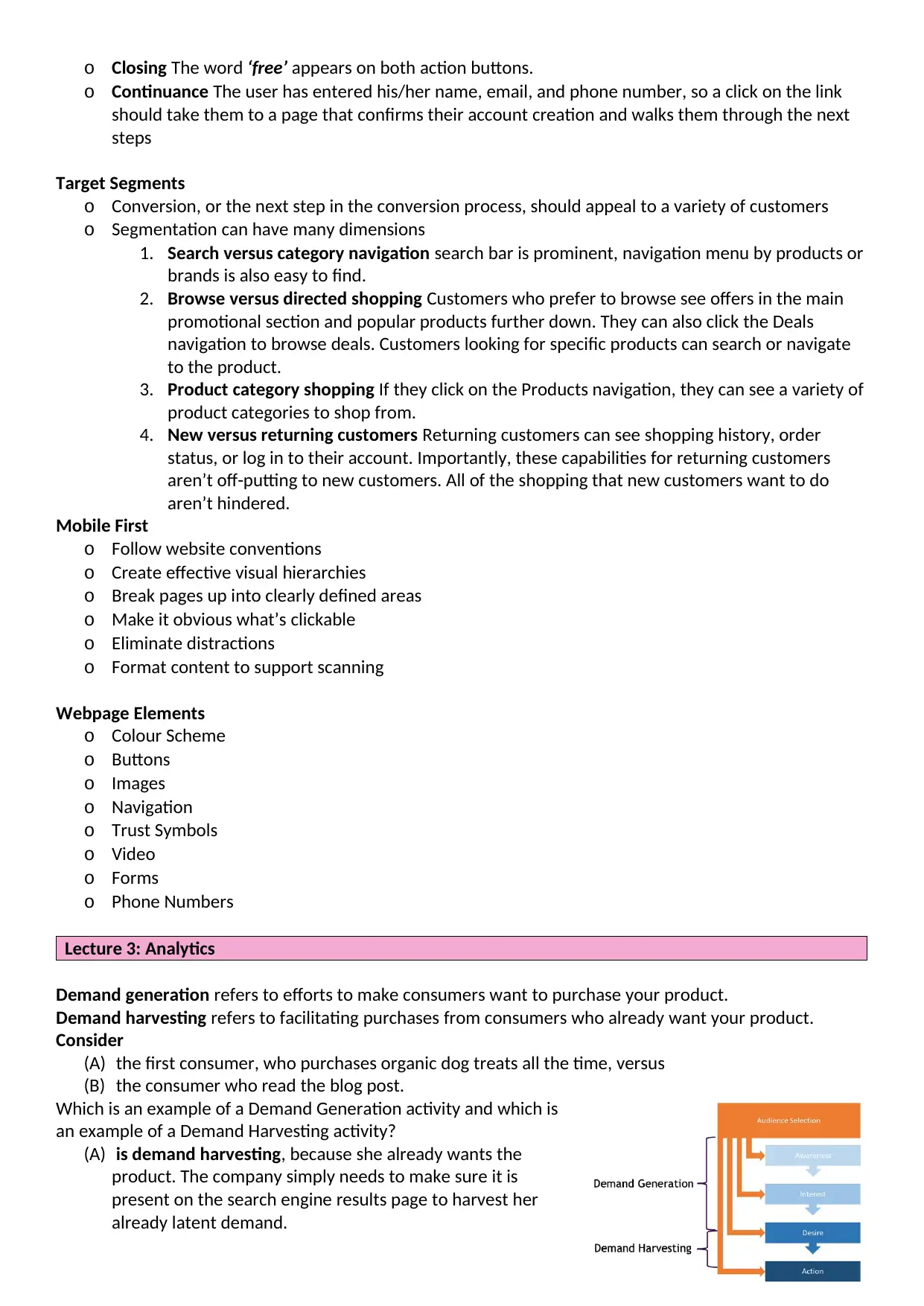
o Closing The word ‘free’ appears on both action buttons.
o Continuance The user has entered his/her name, email, and phone number, so a click on the link
should take them to a page that confirms their account creation and walks them through the next
steps
Target Segments
o Conversion, or the next step in the conversion process, should appeal to a variety of customers
o Segmentation can have many dimensions
1. Search versus category navigation search bar is prominent, navigation menu by products or
brands is also easy to find.
2. Browse versus directed shopping Customers who prefer to browse see offers in the main
promotional section and popular products further down. They can also click the Deals
navigation to browse deals. Customers looking for specific products can search or navigate
to the product.
3. Product category shopping If they click on the Products navigation, they can see a variety of
product categories to shop from.
4. New versus returning customers Returning customers can see shopping history, order
status, or log in to their account. Importantly, these capabilities for returning customers
aren’t off-putting to new customers. All of the shopping that new customers want to do
aren’t hindered.
Mobile First
o Follow website conventions
o Create effective visual hierarchies
o Break pages up into clearly defined areas
o Make it obvious what’s clickable
o Eliminate distractions
o Format content to support scanning
Webpage Elements
o Colour Scheme
o Buttons
o Images
o Navigation
o Trust Symbols
o Video
o Forms
o Phone Numbers
Lecture 3: Analytics
Demand generation refers to efforts to make consumers want to purchase your product.
Demand harvesting refers to facilitating purchases from consumers who already want your product.
Consider
(A) the first consumer, who purchases organic dog treats all the time, versus
(B) the consumer who read the blog post.
Which is an example of a Demand Generation activity and which is
an example of a Demand Harvesting activity?
(A) is demand harvesting, because she already wants the
product. The company simply needs to make sure it is
present on the search engine results page to harvest her
already latent demand.
o Continuance The user has entered his/her name, email, and phone number, so a click on the link
should take them to a page that confirms their account creation and walks them through the next
steps
Target Segments
o Conversion, or the next step in the conversion process, should appeal to a variety of customers
o Segmentation can have many dimensions
1. Search versus category navigation search bar is prominent, navigation menu by products or
brands is also easy to find.
2. Browse versus directed shopping Customers who prefer to browse see offers in the main
promotional section and popular products further down. They can also click the Deals
navigation to browse deals. Customers looking for specific products can search or navigate
to the product.
3. Product category shopping If they click on the Products navigation, they can see a variety of
product categories to shop from.
4. New versus returning customers Returning customers can see shopping history, order
status, or log in to their account. Importantly, these capabilities for returning customers
aren’t off-putting to new customers. All of the shopping that new customers want to do
aren’t hindered.
Mobile First
o Follow website conventions
o Create effective visual hierarchies
o Break pages up into clearly defined areas
o Make it obvious what’s clickable
o Eliminate distractions
o Format content to support scanning
Webpage Elements
o Colour Scheme
o Buttons
o Images
o Navigation
o Trust Symbols
o Video
o Forms
o Phone Numbers
Lecture 3: Analytics
Demand generation refers to efforts to make consumers want to purchase your product.
Demand harvesting refers to facilitating purchases from consumers who already want your product.
Consider
(A) the first consumer, who purchases organic dog treats all the time, versus
(B) the consumer who read the blog post.
Which is an example of a Demand Generation activity and which is
an example of a Demand Harvesting activity?
(A) is demand harvesting, because she already wants the
product. The company simply needs to make sure it is
present on the search engine results page to harvest her
already latent demand.
⊘ This is a preview!⊘
Do you want full access?
Subscribe today to unlock all pages.

Trusted by 1+ million students worldwide
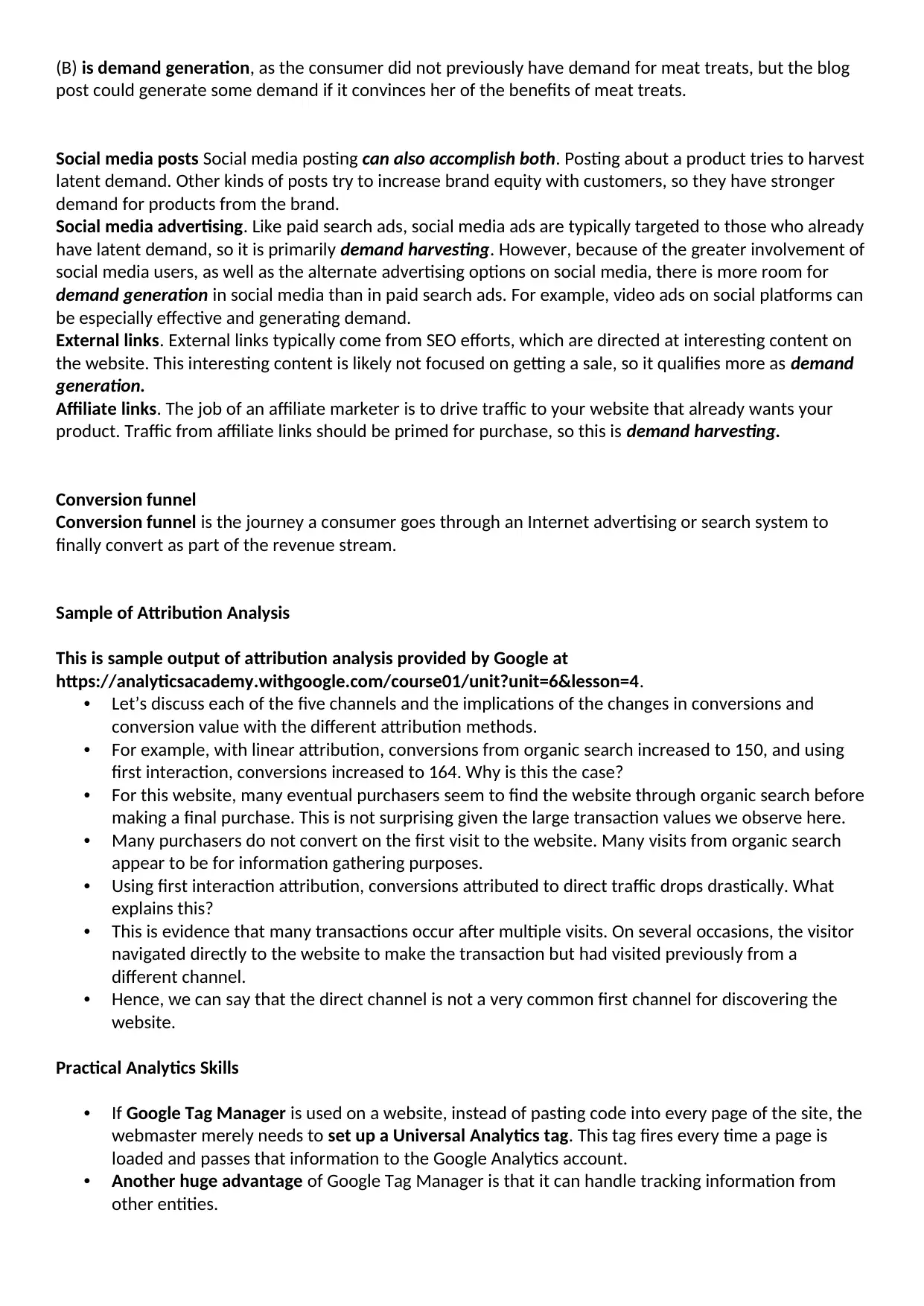
(B) is demand generation, as the consumer did not previously have demand for meat treats, but the blog
post could generate some demand if it convinces her of the benefits of meat treats.
Social media posts Social media posting can also accomplish both. Posting about a product tries to harvest
latent demand. Other kinds of posts try to increase brand equity with customers, so they have stronger
demand for products from the brand.
Social media advertising. Like paid search ads, social media ads are typically targeted to those who already
have latent demand, so it is primarily demand harvesting. However, because of the greater involvement of
social media users, as well as the alternate advertising options on social media, there is more room for
demand generation in social media than in paid search ads. For example, video ads on social platforms can
be especially effective and generating demand.
External links. External links typically come from SEO efforts, which are directed at interesting content on
the website. This interesting content is likely not focused on getting a sale, so it qualifies more as demand
generation.
Affiliate links. The job of an affiliate marketer is to drive traffic to your website that already wants your
product. Traffic from affiliate links should be primed for purchase, so this is demand harvesting.
Conversion funnel
Conversion funnel is the journey a consumer goes through an Internet advertising or search system to
finally convert as part of the revenue stream.
Sample of Attribution Analysis
This is sample output of attribution analysis provided by Google at
https://analyticsacademy.withgoogle.com/course01/unit?unit=6&lesson=4.
• Let’s discuss each of the five channels and the implications of the changes in conversions and
conversion value with the different attribution methods.
• For example, with linear attribution, conversions from organic search increased to 150, and using
first interaction, conversions increased to 164. Why is this the case?
• For this website, many eventual purchasers seem to find the website through organic search before
making a final purchase. This is not surprising given the large transaction values we observe here.
• Many purchasers do not convert on the first visit to the website. Many visits from organic search
appear to be for information gathering purposes.
• Using first interaction attribution, conversions attributed to direct traffic drops drastically. What
explains this?
• This is evidence that many transactions occur after multiple visits. On several occasions, the visitor
navigated directly to the website to make the transaction but had visited previously from a
different channel.
• Hence, we can say that the direct channel is not a very common first channel for discovering the
website.
Practical Analytics Skills
• If Google Tag Manager is used on a website, instead of pasting code into every page of the site, the
webmaster merely needs to set up a Universal Analytics tag. This tag fires every time a page is
loaded and passes that information to the Google Analytics account.
• Another huge advantage of Google Tag Manager is that it can handle tracking information from
other entities.
post could generate some demand if it convinces her of the benefits of meat treats.
Social media posts Social media posting can also accomplish both. Posting about a product tries to harvest
latent demand. Other kinds of posts try to increase brand equity with customers, so they have stronger
demand for products from the brand.
Social media advertising. Like paid search ads, social media ads are typically targeted to those who already
have latent demand, so it is primarily demand harvesting. However, because of the greater involvement of
social media users, as well as the alternate advertising options on social media, there is more room for
demand generation in social media than in paid search ads. For example, video ads on social platforms can
be especially effective and generating demand.
External links. External links typically come from SEO efforts, which are directed at interesting content on
the website. This interesting content is likely not focused on getting a sale, so it qualifies more as demand
generation.
Affiliate links. The job of an affiliate marketer is to drive traffic to your website that already wants your
product. Traffic from affiliate links should be primed for purchase, so this is demand harvesting.
Conversion funnel
Conversion funnel is the journey a consumer goes through an Internet advertising or search system to
finally convert as part of the revenue stream.
Sample of Attribution Analysis
This is sample output of attribution analysis provided by Google at
https://analyticsacademy.withgoogle.com/course01/unit?unit=6&lesson=4.
• Let’s discuss each of the five channels and the implications of the changes in conversions and
conversion value with the different attribution methods.
• For example, with linear attribution, conversions from organic search increased to 150, and using
first interaction, conversions increased to 164. Why is this the case?
• For this website, many eventual purchasers seem to find the website through organic search before
making a final purchase. This is not surprising given the large transaction values we observe here.
• Many purchasers do not convert on the first visit to the website. Many visits from organic search
appear to be for information gathering purposes.
• Using first interaction attribution, conversions attributed to direct traffic drops drastically. What
explains this?
• This is evidence that many transactions occur after multiple visits. On several occasions, the visitor
navigated directly to the website to make the transaction but had visited previously from a
different channel.
• Hence, we can say that the direct channel is not a very common first channel for discovering the
website.
Practical Analytics Skills
• If Google Tag Manager is used on a website, instead of pasting code into every page of the site, the
webmaster merely needs to set up a Universal Analytics tag. This tag fires every time a page is
loaded and passes that information to the Google Analytics account.
• Another huge advantage of Google Tag Manager is that it can handle tracking information from
other entities.
Paraphrase This Document
Need a fresh take? Get an instant paraphrase of this document with our AI Paraphraser
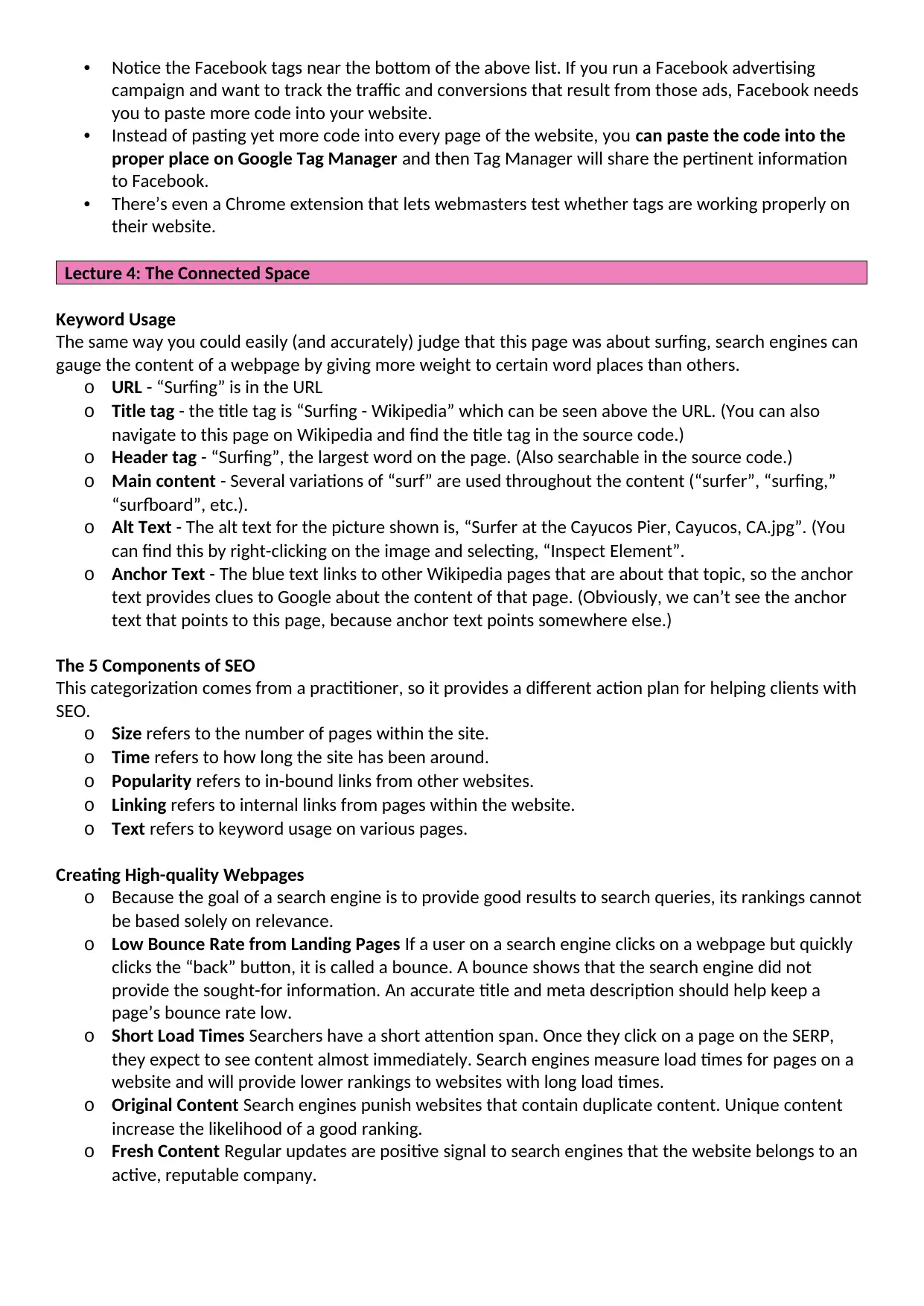
• Notice the Facebook tags near the bottom of the above list. If you run a Facebook advertising
campaign and want to track the traffic and conversions that result from those ads, Facebook needs
you to paste more code into your website.
• Instead of pasting yet more code into every page of the website, you can paste the code into the
proper place on Google Tag Manager and then Tag Manager will share the pertinent information
to Facebook.
• There’s even a Chrome extension that lets webmasters test whether tags are working properly on
their website.
Lecture 4: The Connected Space
Keyword Usage
The same way you could easily (and accurately) judge that this page was about surfing, search engines can
gauge the content of a webpage by giving more weight to certain word places than others.
o URL - “Surfing” is in the URL
o Title tag - the title tag is “Surfing - Wikipedia” which can be seen above the URL. (You can also
navigate to this page on Wikipedia and find the title tag in the source code.)
o Header tag - “Surfing”, the largest word on the page. (Also searchable in the source code.)
o Main content - Several variations of “surf” are used throughout the content (“surfer”, “surfing,”
“surfboard”, etc.).
o Alt Text - The alt text for the picture shown is, “Surfer at the Cayucos Pier, Cayucos, CA.jpg”. (You
can find this by right-clicking on the image and selecting, “Inspect Element”.
o Anchor Text - The blue text links to other Wikipedia pages that are about that topic, so the anchor
text provides clues to Google about the content of that page. (Obviously, we can’t see the anchor
text that points to this page, because anchor text points somewhere else.)
The 5 Components of SEO
This categorization comes from a practitioner, so it provides a different action plan for helping clients with
SEO.
o Size refers to the number of pages within the site.
o Time refers to how long the site has been around.
o Popularity refers to in-bound links from other websites.
o Linking refers to internal links from pages within the website.
o Text refers to keyword usage on various pages.
Creating High-quality Webpages
o Because the goal of a search engine is to provide good results to search queries, its rankings cannot
be based solely on relevance.
o Low Bounce Rate from Landing Pages If a user on a search engine clicks on a webpage but quickly
clicks the “back” button, it is called a bounce. A bounce shows that the search engine did not
provide the sought-for information. An accurate title and meta description should help keep a
page’s bounce rate low.
o Short Load Times Searchers have a short attention span. Once they click on a page on the SERP,
they expect to see content almost immediately. Search engines measure load times for pages on a
website and will provide lower rankings to websites with long load times.
o Original Content Search engines punish websites that contain duplicate content. Unique content
increase the likelihood of a good ranking.
o Fresh Content Regular updates are positive signal to search engines that the website belongs to an
active, reputable company.
campaign and want to track the traffic and conversions that result from those ads, Facebook needs
you to paste more code into your website.
• Instead of pasting yet more code into every page of the website, you can paste the code into the
proper place on Google Tag Manager and then Tag Manager will share the pertinent information
to Facebook.
• There’s even a Chrome extension that lets webmasters test whether tags are working properly on
their website.
Lecture 4: The Connected Space
Keyword Usage
The same way you could easily (and accurately) judge that this page was about surfing, search engines can
gauge the content of a webpage by giving more weight to certain word places than others.
o URL - “Surfing” is in the URL
o Title tag - the title tag is “Surfing - Wikipedia” which can be seen above the URL. (You can also
navigate to this page on Wikipedia and find the title tag in the source code.)
o Header tag - “Surfing”, the largest word on the page. (Also searchable in the source code.)
o Main content - Several variations of “surf” are used throughout the content (“surfer”, “surfing,”
“surfboard”, etc.).
o Alt Text - The alt text for the picture shown is, “Surfer at the Cayucos Pier, Cayucos, CA.jpg”. (You
can find this by right-clicking on the image and selecting, “Inspect Element”.
o Anchor Text - The blue text links to other Wikipedia pages that are about that topic, so the anchor
text provides clues to Google about the content of that page. (Obviously, we can’t see the anchor
text that points to this page, because anchor text points somewhere else.)
The 5 Components of SEO
This categorization comes from a practitioner, so it provides a different action plan for helping clients with
SEO.
o Size refers to the number of pages within the site.
o Time refers to how long the site has been around.
o Popularity refers to in-bound links from other websites.
o Linking refers to internal links from pages within the website.
o Text refers to keyword usage on various pages.
Creating High-quality Webpages
o Because the goal of a search engine is to provide good results to search queries, its rankings cannot
be based solely on relevance.
o Low Bounce Rate from Landing Pages If a user on a search engine clicks on a webpage but quickly
clicks the “back” button, it is called a bounce. A bounce shows that the search engine did not
provide the sought-for information. An accurate title and meta description should help keep a
page’s bounce rate low.
o Short Load Times Searchers have a short attention span. Once they click on a page on the SERP,
they expect to see content almost immediately. Search engines measure load times for pages on a
website and will provide lower rankings to websites with long load times.
o Original Content Search engines punish websites that contain duplicate content. Unique content
increase the likelihood of a good ranking.
o Fresh Content Regular updates are positive signal to search engines that the website belongs to an
active, reputable company.
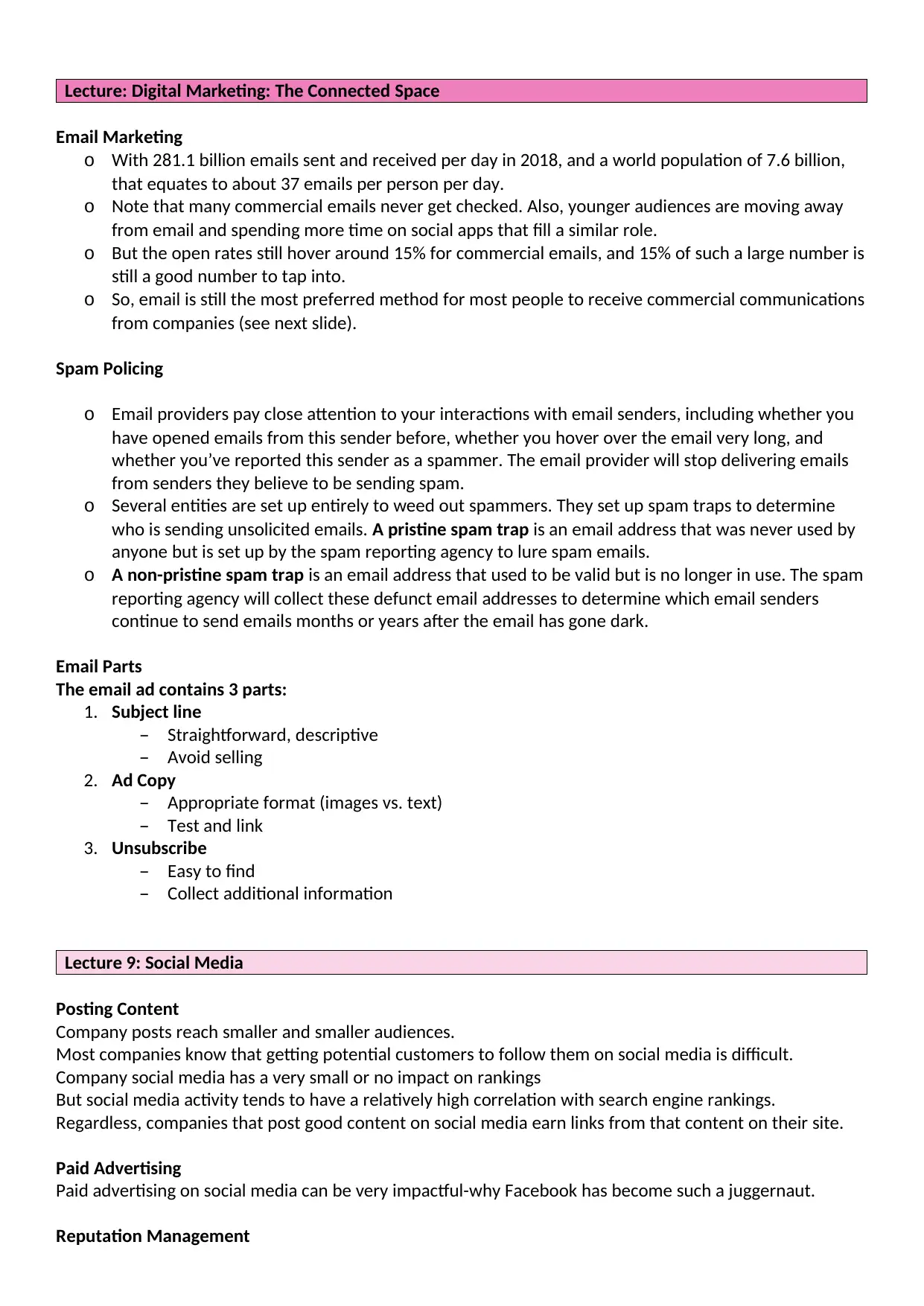
Lecture: Digital Marketing: The Connected Space
Email Marketing
o With 281.1 billion emails sent and received per day in 2018, and a world population of 7.6 billion,
that equates to about 37 emails per person per day.
o Note that many commercial emails never get checked. Also, younger audiences are moving away
from email and spending more time on social apps that fill a similar role.
o But the open rates still hover around 15% for commercial emails, and 15% of such a large number is
still a good number to tap into.
o So, email is still the most preferred method for most people to receive commercial communications
from companies (see next slide).
Spam Policing
o Email providers pay close attention to your interactions with email senders, including whether you
have opened emails from this sender before, whether you hover over the email very long, and
whether you’ve reported this sender as a spammer. The email provider will stop delivering emails
from senders they believe to be sending spam.
o Several entities are set up entirely to weed out spammers. They set up spam traps to determine
who is sending unsolicited emails. A pristine spam trap is an email address that was never used by
anyone but is set up by the spam reporting agency to lure spam emails.
o A non-pristine spam trap is an email address that used to be valid but is no longer in use. The spam
reporting agency will collect these defunct email addresses to determine which email senders
continue to send emails months or years after the email has gone dark.
Email Parts
The email ad contains 3 parts:
1. Subject line
– Straightforward, descriptive
– Avoid selling
2. Ad Copy
– Appropriate format (images vs. text)
– Test and link
3. Unsubscribe
– Easy to find
– Collect additional information
Lecture 9: Social Media
Posting Content
Company posts reach smaller and smaller audiences.
Most companies know that getting potential customers to follow them on social media is difficult.
Company social media has a very small or no impact on rankings
But social media activity tends to have a relatively high correlation with search engine rankings.
Regardless, companies that post good content on social media earn links from that content on their site.
Paid Advertising
Paid advertising on social media can be very impactful-why Facebook has become such a juggernaut.
Reputation Management
Email Marketing
o With 281.1 billion emails sent and received per day in 2018, and a world population of 7.6 billion,
that equates to about 37 emails per person per day.
o Note that many commercial emails never get checked. Also, younger audiences are moving away
from email and spending more time on social apps that fill a similar role.
o But the open rates still hover around 15% for commercial emails, and 15% of such a large number is
still a good number to tap into.
o So, email is still the most preferred method for most people to receive commercial communications
from companies (see next slide).
Spam Policing
o Email providers pay close attention to your interactions with email senders, including whether you
have opened emails from this sender before, whether you hover over the email very long, and
whether you’ve reported this sender as a spammer. The email provider will stop delivering emails
from senders they believe to be sending spam.
o Several entities are set up entirely to weed out spammers. They set up spam traps to determine
who is sending unsolicited emails. A pristine spam trap is an email address that was never used by
anyone but is set up by the spam reporting agency to lure spam emails.
o A non-pristine spam trap is an email address that used to be valid but is no longer in use. The spam
reporting agency will collect these defunct email addresses to determine which email senders
continue to send emails months or years after the email has gone dark.
Email Parts
The email ad contains 3 parts:
1. Subject line
– Straightforward, descriptive
– Avoid selling
2. Ad Copy
– Appropriate format (images vs. text)
– Test and link
3. Unsubscribe
– Easy to find
– Collect additional information
Lecture 9: Social Media
Posting Content
Company posts reach smaller and smaller audiences.
Most companies know that getting potential customers to follow them on social media is difficult.
Company social media has a very small or no impact on rankings
But social media activity tends to have a relatively high correlation with search engine rankings.
Regardless, companies that post good content on social media earn links from that content on their site.
Paid Advertising
Paid advertising on social media can be very impactful-why Facebook has become such a juggernaut.
Reputation Management
⊘ This is a preview!⊘
Do you want full access?
Subscribe today to unlock all pages.

Trusted by 1+ million students worldwide
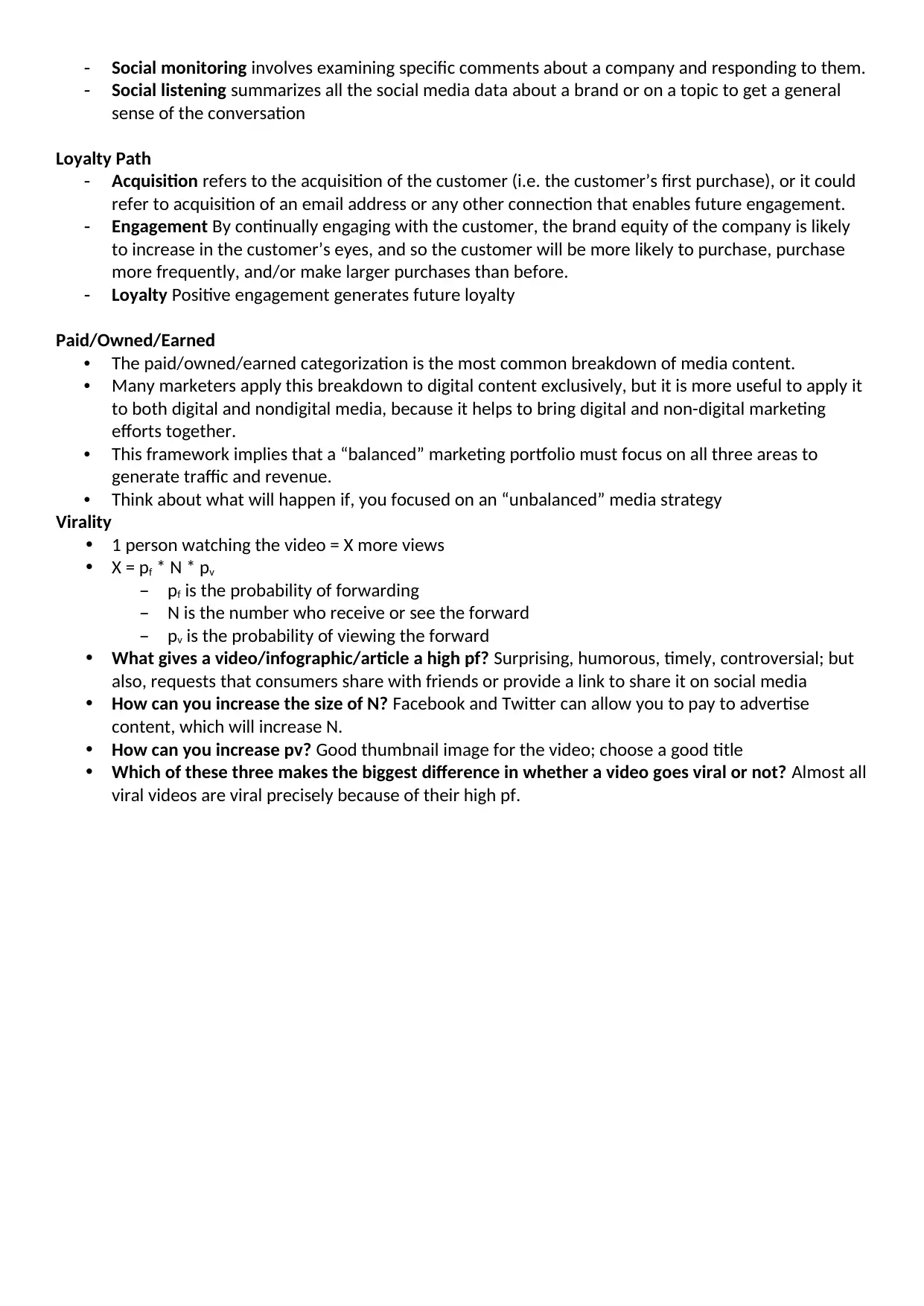
- Social monitoring involves examining specific comments about a company and responding to them.
- Social listening summarizes all the social media data about a brand or on a topic to get a general
sense of the conversation
Loyalty Path
- Acquisition refers to the acquisition of the customer (i.e. the customer’s first purchase), or it could
refer to acquisition of an email address or any other connection that enables future engagement.
- Engagement By continually engaging with the customer, the brand equity of the company is likely
to increase in the customer’s eyes, and so the customer will be more likely to purchase, purchase
more frequently, and/or make larger purchases than before.
- Loyalty Positive engagement generates future loyalty
Paid/Owned/Earned
• The paid/owned/earned categorization is the most common breakdown of media content.
• Many marketers apply this breakdown to digital content exclusively, but it is more useful to apply it
to both digital and nondigital media, because it helps to bring digital and non-digital marketing
efforts together.
• This framework implies that a “balanced” marketing portfolio must focus on all three areas to
generate traffic and revenue.
• Think about what will happen if, you focused on an “unbalanced” media strategy
Virality
• 1 person watching the video = X more views
• X = pf * N * pv
– pf is the probability of forwarding
– N is the number who receive or see the forward
– pv is the probability of viewing the forward
• What gives a video/infographic/article a high pf? Surprising, humorous, timely, controversial; but
also, requests that consumers share with friends or provide a link to share it on social media
• How can you increase the size of N? Facebook and Twitter can allow you to pay to advertise
content, which will increase N.
• How can you increase pv? Good thumbnail image for the video; choose a good title
• Which of these three makes the biggest difference in whether a video goes viral or not? Almost all
viral videos are viral precisely because of their high pf.
- Social listening summarizes all the social media data about a brand or on a topic to get a general
sense of the conversation
Loyalty Path
- Acquisition refers to the acquisition of the customer (i.e. the customer’s first purchase), or it could
refer to acquisition of an email address or any other connection that enables future engagement.
- Engagement By continually engaging with the customer, the brand equity of the company is likely
to increase in the customer’s eyes, and so the customer will be more likely to purchase, purchase
more frequently, and/or make larger purchases than before.
- Loyalty Positive engagement generates future loyalty
Paid/Owned/Earned
• The paid/owned/earned categorization is the most common breakdown of media content.
• Many marketers apply this breakdown to digital content exclusively, but it is more useful to apply it
to both digital and nondigital media, because it helps to bring digital and non-digital marketing
efforts together.
• This framework implies that a “balanced” marketing portfolio must focus on all three areas to
generate traffic and revenue.
• Think about what will happen if, you focused on an “unbalanced” media strategy
Virality
• 1 person watching the video = X more views
• X = pf * N * pv
– pf is the probability of forwarding
– N is the number who receive or see the forward
– pv is the probability of viewing the forward
• What gives a video/infographic/article a high pf? Surprising, humorous, timely, controversial; but
also, requests that consumers share with friends or provide a link to share it on social media
• How can you increase the size of N? Facebook and Twitter can allow you to pay to advertise
content, which will increase N.
• How can you increase pv? Good thumbnail image for the video; choose a good title
• Which of these three makes the biggest difference in whether a video goes viral or not? Almost all
viral videos are viral precisely because of their high pf.
1 out of 7
Related Documents
Your All-in-One AI-Powered Toolkit for Academic Success.
+13062052269
info@desklib.com
Available 24*7 on WhatsApp / Email
![[object Object]](/_next/static/media/star-bottom.7253800d.svg)
Unlock your academic potential
Copyright © 2020–2025 A2Z Services. All Rights Reserved. Developed and managed by ZUCOL.





